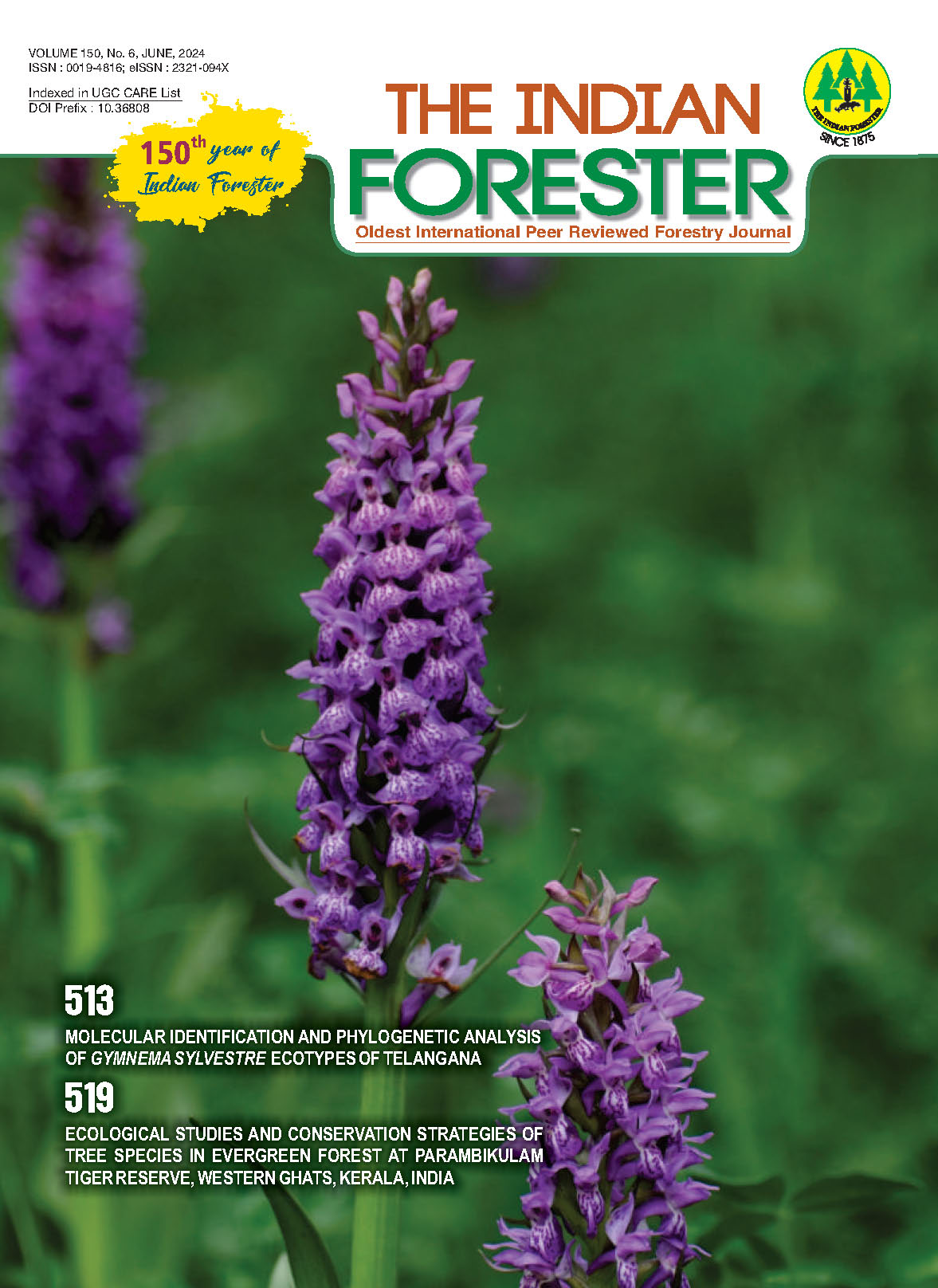Four New Records of Corticioid Fungi from Temperate Forests of Himachal Pradesh (India)
DOI:
https://doi.org/10.36808/if/2024/v150i6/169876Keywords:
Wood rot, Himalaya, Fungi, Basidiomycota, Mycoflora, Clamp connection.Abstract
Corticioid fungi form an important group of wood decaying organisms in the forest ecosystem. These fungi play vital role in the recycling of carbon because of their unique ability to secrete lignin and cellulose decaying enzymes. The forest ecosystems in different parts of the world are being over exploited for timber and other forest products. Taking into consideration of this fact the present studies on the diversity of corticioid fungi growing in association with wood, from temperate forests of Himachal Pradesh (India) were planned. Basidiocarps specimens of corticioid fungi were collected during the fungal forays conducted in temperate forests of Kullu district (Himachal Pradesh, India). These specimens were thoroughly investigated and described based on their macro and micro-morphological features. Four species of wood rotting fungi collected from wood of Cedrus deodara in the temperate forests of Kullu district are described as Athelopsis fusoidea (Jülich) TellerÃa, A. glaucina (Bourdot & Galzin) Oberw. ex Parmasto, Hyphoderma floccosum C.L. Zhao & Q.X. Guan and Rhizochaete sulphurina (P. Karst.) K.H. Larss. All the four species are new to India.
References
Bernicchia A. and Gorjón S.P. (2010). Corticiaceaes.l. Fungi Europaei 12. Edizioni Candusso, Alassio, Italia +1008pp.
Bhosle S.R., Lamrood P.Y. and Vaidya J.G. (2005). Diversity of AphyllophoraceousFungi from the Western Ghats of Maharashtra. The Fungi – Diversity and Conservation in India (eds. Dargan, J.S., Atri, N.S. and Dhingra, G.S.). Bishen Singh Mahendra Pal Singh Dehradun. 103–113.
Chikowski R.S., Larsson K.H. and Gibertoni T.B. (2016). Three new combinations in Rhizochaete (Agaricomycetes, Fungi) and a new record to the Brazilian Amazonia. Nova Hedwigia, 102(1-2): 185-196.
Dhaliwal D.S. and Sharma M. (1999). Flora of Kullu district (Himachal Pradesh). Bishen Singh Mahender Pal Singh, Dehradun +744pp.
Dhingra G.S., Priyanka and Kaur J. (2011). A checklist of resupinate, non–poroid Agaricomycetes fungi from North–East India and Bhutan. Synopsis Fungorum, 29: 22–70.
Dhingra G.S., Singh A.P., Kaur J., Priyanka, Kaur H., Rani M., Sood S., Singla N., Kaur H., Jain N., Gupta S., Kaur M., Sharma J., Rajnish and Kaur G. (2014). A checklist of resupinate, non–poroid Agaricomycetous fungi from Himachal Pradesh, India. Synopsis Fungorum, 32: 8–37.
Gorjon S.P. (2020). Genera of corticioid fungi: keys, nomenclature and taxonomy. Studies in Fungi, 5(1): 125–309.
Guan Q.X. and Zhao C.L. (2021). Taxonomy and phylogeny of the wood inhabiting fungal genus Hyphoderma with descriptions of three new species from East Asia. Journal of Fungi, 7(4): 308.
Kirk P.M., Cannon P.F., Minter D.W. and Stalpers J.A. (2008). Dictionary of the Fungi (10thed.), Wallingford, Oxon, UK +771pp.
Kornerup A. and Wanscher J.H. (1978). Metheun's Handbook of colours, 3rd Ed. Metheun and Co., London +252 pp.
Lonsdale D., Pautasso M. and Holdenrieder O. (2008). Wood decaying fungi in the forest: conservation needs and management options. European Journal of Forest Research, 127: 1–22.
Manoharachary C., Atri N.S., Devi T.P., Kamil D., Singh S.K. and Singh A.P. (2022). Bilgrami's fungi of India list and references (1988–2020). Today and tomorrow's printers and publishers, New Dehli +412pp.
Mycobank (2023). Fungal databases. Nomenclature and species banks. http:// www.mycobank.org/ (accessed 10 January 2023).
Rattan S.S. (1977). The resupinate Aphyllophorales of the North-Western Himalayas. Bibliotheca Mycologica 60, Cramer, Germany +427pp.
Sanyal S.K., Devi R. and Dhingra G.S. (2017). New records of Hyphoderma (Meruliaceae, Polyporales) for India.The Scientific World Journal +11pp.
Sharma J.R. (2012). Aphyllophorales of Himalaya. Botanical Survey of India, Ministry of Environment & Forests, Government of India, Kolkata, India +590pp.
Yurchenko E.O. (2006). Natural substrate for corticioid fungi. Acta Mycologica, 41(1): 113–124.
Downloads
Downloads
Published
How to Cite
Issue
Section
License
Unless otherwise stated, copyright or similar rights in all materials presented on the site, including graphical images, are owned by Indian Forester.





